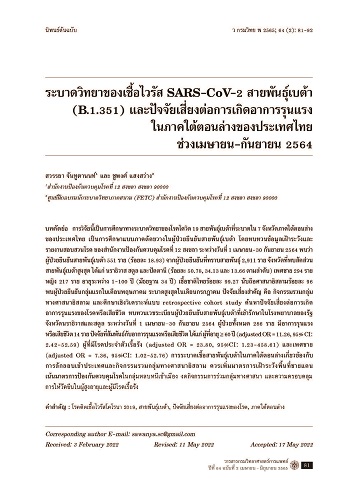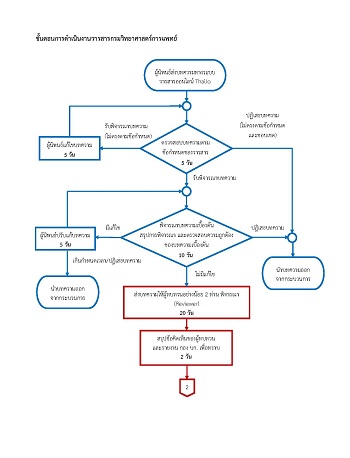ระบาดวิทยาของเชื้อไวรัส SARS-CoV-2 สายพันธุ์เบต้า (B.1.351) และปัจจัยเสี่ยงต่อการเกิดอาการรุุนแรงในภาคใต้ตอนล่างของประเทศไทย ช่วงเมษายน-กันยายน 2564
คำสำคัญ:
โรคติดเชื้อไวรัสโคโรนา 2019, สายพันธุ์เบต้า, ปัจจัยเสี่ยงต่ออาการรุนแรงของโรค, ภาคใต้ตอนล่างบทคัดย่อ
การวิจัยนี้เป็นการศึกษาทางระบาดวิทยาของโรคโควิด 19 สายพันธุ์เบต้าที่ระบาดใน 7 จังหวัดภาคใต้ตอนล่างของประเทศไทย เป็นการศึกษาแบบภาคตัดขวางในผู้ป่วยยืนยันสายพันธุ์เบต้า โดยทบทวนข้อมูลเฝ้าระวังและรายงานสอบสวนโรคของสำนักงานป้องกันควบคุมโรคที่ 12 สงขลา ระหว่างวันที่ 1 เมษายน-30 กันยายน 2564 พบว่าผู้ป่วยยืนยันสายพันธุ์เบต้า 551 ราย (ร้อยละ 18.93) จากผู้ป่วยยืนยันที่ทราบสายพันธุ์ 2,911 ราย จังหวัดที่พบสัดส่วนสายพันธุ์เบต้าสูงสุด ได้แก่ นราธิวาส สตูล และปัตตานี (ร้อยละ 50.78, 34.13 และ 13.66 ตามลำดับ) เพศชาย 294 ราย หญิง 217 ราย อายุระหว่าง 1-100 ปี (มัธยฐาน 34 ปี) เชื้อชาติไทยร้อยละ 99.27 นับถือศาสนาอิสลามร้อยละ 96 พบผู้ป่วยยืนยันกลุ่มแรกในเดือนพฤษภาคม ระบาดสูงสุดในเดือนกรกฎาคม ปัจจัยเสี่ยงสำคัญ คือ กิจกรรมรวมกลุ่มทางศาสนาอิสลาม และศึกษาเชิงวิเคราะห์แบบ retrospective cohort study ค้นหาปัจจัยเสี่ยงต่อการเกิดอาการรุนแรงของโรคหรือเสียชีวิต ทบทวนเวชระเบียนผู้ป่วยยืนยันสายพันธุ์เบต้าที่เข้ารักษาในโรงพยาบาลของรัฐ จังหวัดนราธิวาสและสตูล ระหว่างวันที่ 1 เมษายน–30 กันยายน 2564 ผู้ป่วยทั้งหมด 286 ราย มีอาการรุนแรงหรือเสียชีวิต 14 ราย ปัจจัยที่สัมพันธ์กับอาการรุนแรงหรือเสียชีวิต ได้แก่ ผู้ที่อายุ ≥ 60 ปี (adjusted OR = 11.26, 95% CI: 2.42-52.59) ผู้ที่มีโรคประจำตัวเรื้อรัง (adjusted OR = 23.80, 95%CI: 1.23-458.61) และเพศชาย (adjusted OR = 7.36, 95%CI: 1.02-52.76) การระบาดเชื้อสายพันธุ์เบต้าในภาคใต้ตอนล่างเกี่ยวข้องกับการลักลอบเข้าประเทศและกิจกรรมรวมกลุ่มทางศาสนาอิสลาม ควรเพิ่มมาตรการเฝ้าระวังพื้นที่ชายแดนเน้นมาตรการป้องกันควบคุมโรคในกลุ่มหลบหนีเข้าเมือง งดกิจกรรมการร่วมกลุ่มทางศาสนา และความครอบคลุมการให้วัคซีนในผู้สูงอายุและผู้มีโรคเรื้อรัง
เอกสารอ้างอิง
World Health Organization. Coronavirus disease (COVID-19). [online]. 2021; [cited 2021 Dec 24]. Available from: URL: https://www.who.int/emergencies/diseases/novel-coronavirus-2019/question-andanswers-hub/q-a-detail/coronavirusdisease-covid-19.
Tang YW, Schmitz JE, Persing DH, Stratton CW. Laboratory diagnosis of COVID-19: current issues and challenges. J Clin Microbiol 2020; 58(6): e00512-20.
World Health Organization. Origin of SARS-CoV-2. [online]. 2020; [cited 2021 Aug 14]; [2 screens]. Available from: URL: https://apps.who.int/iris/bitstream/handle/10665/332197/WHO-2019-nCoV-FAQ-Virus_origin-2020.1-eng.pdf.
World Health Organization. WHO-convened global study of origins of SARS-CoV-2: China part. [online]. 2021; [cited 2021 Aug 14]; [120 screens]. Available from: URL: https://www.who.int/publications/i/item/whoconvened-global-study-of-origins-of-sarscov-2-china-part.
ProMED-mail. Novel coronavirus (02): Thailand ex China (HU) WHO. Archive Number: 20200113.6886644. [online]. 2020; [cited 2022 Jan 19]. Available from: URL: https://promedmail.org/promedpost/?id=20200113.6886644.
Cov-lineages.org. Lineage list. [online]. 2019; [cited 2022 Jan 19]. Available from: URL: https://cov-lineages.org/lineage_list.html.
World Health Organization. Episode #39-update on virus variants. [online]. 2021; [cited 2022 Jan 14]. Available from: URL: https://www.who.int/emergencies/diseases/novel-coronavirus-2019/mediaresources/science-in-5/episode-39---update-on-virus-variants.
World Health Organization. Tracking SARS-CoV-2 variants. [online]. 2021; [cited 2022 Jan 19]. Available from: URL: https://www.who.int/activities/tracking-SARS-CoV-2-variants.
World Health Organization. Naming the coronavirus disease (COVID-19) and the virus that causes it. [online]. 2020; [cited 2022 Jan 14]; [2 screens]. Available from: URL: https://www.who.int/emergencies/diseases/novel-coronavirus-2019/technical-guidance/naming-the-coronavirusdisease-(covid-2019)-and-the-virusthat-causes-it.
Liu Y, Rocklöv J. The reproductive number of the Delta variant of SARS-CoV-2 is far higher compared to the ancestral SARS-CoV-2 virus. J Travel Med 2021; 28(7): taab124. (3 pages).
Manatu H. Covid-19 variants update. [online]. 2021; [cited 2021 Nov 28]; [67 screens]. Available from: URL: https://www.health.govt.nz/system/files/documents/pages/variants-update-27-april-2022_0.pdf.
Paredes MI, Lunn SM, Famulare M, Frisbie LA, Painter I, Burstein R, et al. Associations between SARS-CoV-2 variants and risk of COVID-19 hospitalization among confirmed cases in Washington State: a retrospective cohort study. Clin Infect Dis 2022; ciac279. (19 pages).
Phiriyasart F, Chantutanon S, Salaeh F, Roka A, Thepparat T, Kaesaman S, et al. Outbreak investigation of coronavirus disease (COVID-19) among Islamic missionaries in southern Thailand, April 2020. OSIR Journal 2020; 13(2): 48-54.
Chailek C, Taweewigyakarn P, Yimchoho N, Saritapirak N, Namwat C, Sawanpanyalert N. Epidemiological characteristics and medical visits of the first 58 COVID-19 deaths, January–June 2020, Thailand. OSIR Journal 2021; 14(1): 1-11.
Team E. The epidemiological characteristics of an outbreak of 2019 novel coronavirus diseases (COVID-19)-China, 2020. China CDC Wkly 2020; 2(8): 113-22.
Centers for Disease Control and Prevention. COVID-19. [online]. 2022; [cited 2022 May 08]. Available from: URL: https://www.cdc.gov/coronavirus/2019-ncov.
Mysiak K. The relationship between significant, power, sample size & effect size. [online]. 2020; [cited 2022 May 08]; [9 screens]. Available from: URL: https://towardsdatascience.com/the-relationshipbetween-significant-power-sample-sizeeffect-size-899fcf95a76d.

ดาวน์โหลด
เผยแพร่แล้ว
รูปแบบการอ้างอิง
ฉบับ
ประเภทบทความ
สัญญาอนุญาต
ลิขสิทธิ์ (c) 2022 วารสารกรมวิทยาศาสตร์การแพทย์

อนุญาตภายใต้เงื่อนไข Creative Commons Attribution-NonCommercial-NoDerivatives 4.0 International License.



